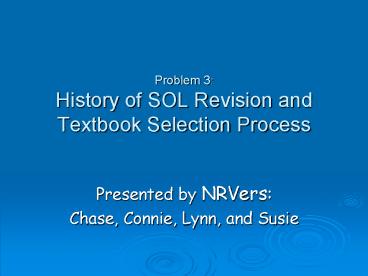Problem 3: History of SOL Revision and Textbook Selection Process - PowerPoint PPT Presentation
1 / 16
Title:
Problem 3: History of SOL Revision and Textbook Selection Process
Description:
Problem 3: History of SOL Revision and Textbook Selection Process Presented by NRVers: Chase, Connie, Lynn, and Susie History of Virginia Leadership since 1995 1995 ... – PowerPoint PPT presentation
Number of Views:113
Avg rating:3.0/5.0
Title: Problem 3: History of SOL Revision and Textbook Selection Process
1
Problem 3History of SOL Revision and Textbook
Selection Process
- Presented by NRVers
- Chase, Connie, Lynn, and Susie
2
History of Virginia Leadership since 1995
- 1995 standards set forth minimum learning content
in English, mathematics, science, social studies,
and computer technology for all students K-12 (VA
Dept. of Ed., 1998) - Dr. William Bosher, Superintendent of Public
Instruction from 1994-1996 - Dr. Richard LaPointe was appointed Superintendent
in 1998 and continued the work of Dr. Bosher - Mr. Paul Stapleton assumed duties as
Superintendent in April 1998 - Dr. JoLynne DeMary became the Superintendent in
1999
3
SOL History since 1995
- Harcourt Brace was contracted to create tests to
measure students progress on revised standards - Statewide field test of new SOLs took place in
Spring 1997 - Assessments were administered in grades 3, 5, and
8 and at the completion of certain high school
courses in Spring 1998
4
Timetable for Revisions to SOLs
- From the beginning of Virginias school reform
initiative, the Board of Education has recognized
the need for an ongoing process of evaluation and
revision. (DOE) - This revision occurs on a six year cycle.
Following this cycle, the textbook adoption
selection takes place the following year
5
SOL Revision Cycle
6
Textbook Selection Process
- DOE follows an established process to review and
recommend textbooks and instructional
material/programs submitted for adoption - After this review, a list is provided on DOE
website along with profile sheets that give
information used to determine the recommendation
7
Text Book Selection Process
8
Textbook Selection Process
9
Textbook Selection Process
- February 2004 DOE revised the criteria and
process for adoption of instructional methods or
models/programs - Recommendation of materials with a proven track
record is not intended as a guarantee that the
program will be successful as implemented in a
particular school - Prior to adopting, a school is expected to align
its curriculum with the SOLs http//www.pen.k12.v
a.us/VDOE/suptsmemos/2004/inf069.html
10
Funding Methodology
- Local level School boards responsibility to
regulate spending of textbook monies - State Level definite funding formula based on
Average Daily Membership (ADM) and other factors - http//www.pen.k12.va.us/VDOE/Finance/Budget/calc
tools.html
11
State Textbook Funding Policies
- Are state funds provided for textbooks?
- In 1996 on average 41.65 per pupil
- Presently on average, 72 per pupil is spent
(Beverly Thurston, DOE Textbook) - http//www.edweek.com/ew/vol-16/21textsb.h16
12
Virginia Standards of LearningWhat Model Was
Used?
- There are elements of two models
- The Tyler Model
- The Taba Model
13
Elements of the Tyler Model
- Learner, society and subject matter as a source
- These sources were used to develop general
objectives to be screened by a philosophy of
education (essentialism) and a psychology of
learning ( how students Learn) in order to get
precise instructional objectives
14
Purpose of the Psychology of Learning Screen
- Enables curriculum planners to distinguish
changes in humans that can be expected to result
from a learning process from those that cannot - Enables curriculum planners to distinguish goals
that are feasible at an appropriate age - Enables curriculum planners to determine an
appropriate length of time to realize a goal
15
Elements of the Taba model
- Variations of a five step sequence
- Producing pilot units
- Testing experimental units
- Revising and consolidating
- Developing a framework
- Installing and disseminating new units
16
Works Cited
- Hill, Linda., Supervisor of Curriculum
Instruction and Assessment, Pulaski County
Schools, April 7, 2004 (Interview Source) - Milne, Phyllis. Virginias Standards of Learning
1969/ 2001 Virginia Educational Leadership Vol
1 No. 1 Spring 2002, pp 30-34. - Oliva, Peter, (2001). Developing the Curriculum
(5th ed.). New York, NY Longman - Patterson, Rick., Director of Business Finance,
Pulaski County Schools, April 7, 2004
(Interview Source) - Thurston, Beverly, Textbook and Instructional
Materials Coordinator, Department of Education,
April 12, 2004 (Interview Source) - http//www.pen.k12.va.us/VDOE/suptsmemos/2004/inf0
69.html - http//www.pen.k12.va.us/VDOE/suptsmemos/2004/reg0
02.html - http//www.pen.k12.va.us/
- http//www.pen.k12.va.us/VDOE/suptsmemos/2001/inf1
52.html - http//www.pen.k12.va.us/VDOE/Superintendent/Sols/
home.shtml - http//www.pen.k12.va.us/VDOE/suptsmemos/2000/inf2
00.html - http//www.pen.k12.va.us/VDOE/suptsmemos/2003/inf0
16.html - http//www.pen.k12.va.us/VDOE/suptsmemos/2003/inf0
15.html - http//www.pen.k12.va.us/VDOE/suptsmemos/2004/inf0
47.html
- http//www.pen.k12.va.us/VDOE/Finance/Budget/c
alctools.html - http//leg1.state.va.us/000/reg/TOC08020.HTM

